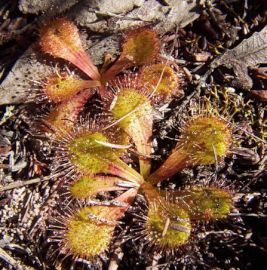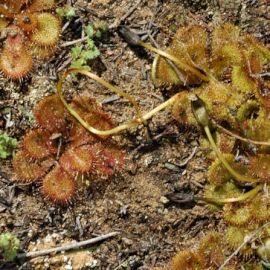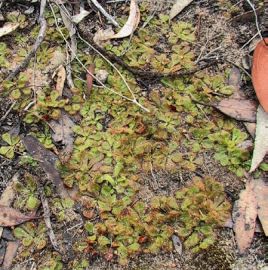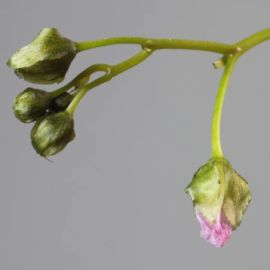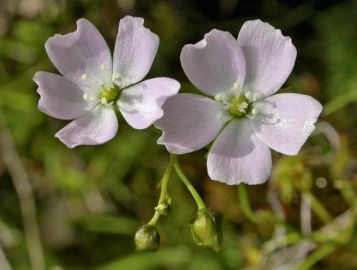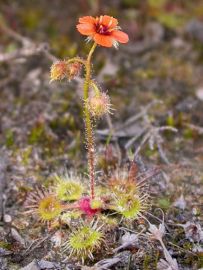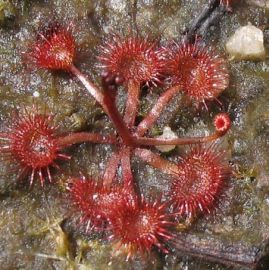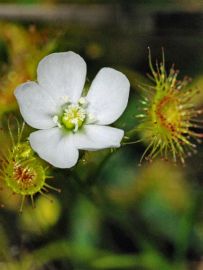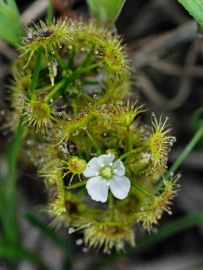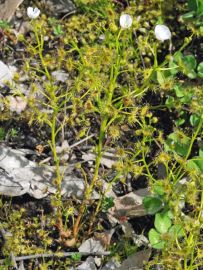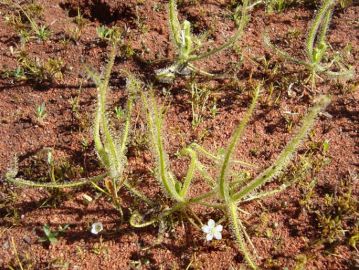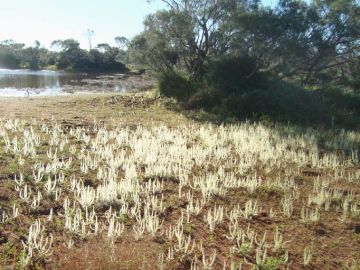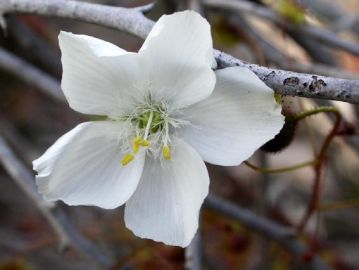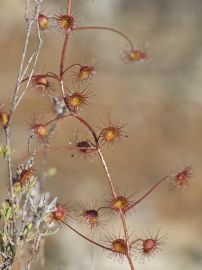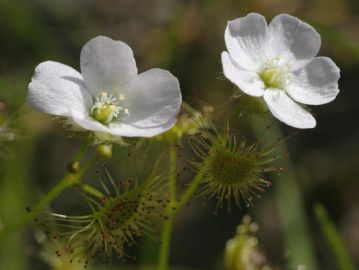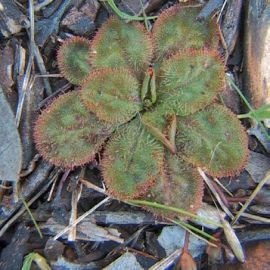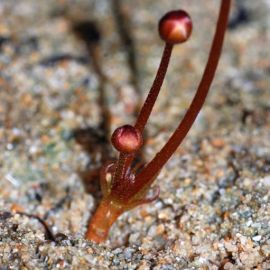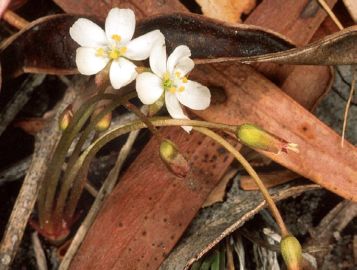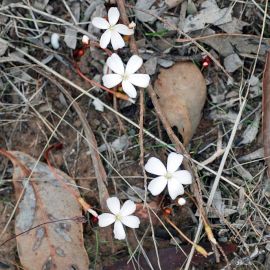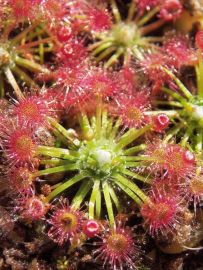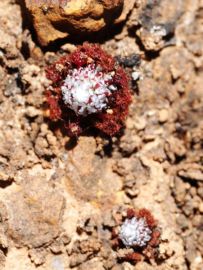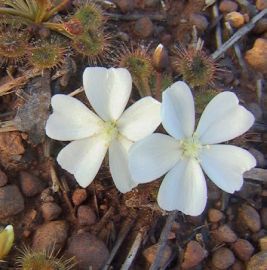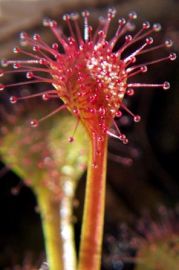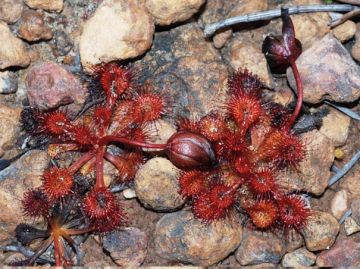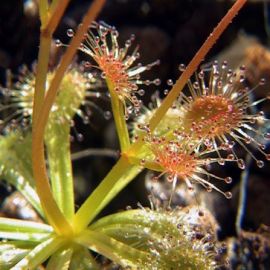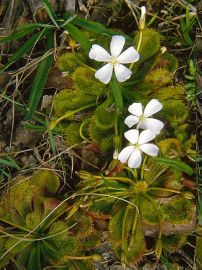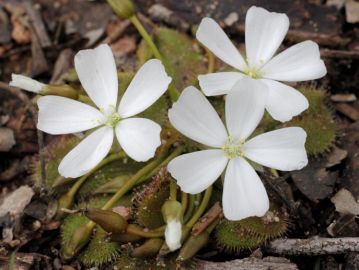J.G. Conran & N.G. Marchant
Annual and perennial herbs, shortly rhizomatous and fibrous-rooted, or with a spherical tuber and vertical stolon, or long-stemmed, rootless aquatic herbs; leaves in a rosette or cauline, alternate or whorled, stipulate or exstipulate; lamina with mucilaginous, sometimes touch sensitive insect-catching glandular hairs or a hinged, touch-sensitive, tooth-edged trap. Flowers regular, bisexual; sepals 4 or 5, free or almost free; petals 4 or 5, free; stamens 4 or 5, free, alternate with the petals; ovary superior, 1-celled; ovules numerous, on 2–5 parietal placentas; styles 3–5, simple or branched. Fruit a loculicidal capsule with persistent calyx; seeds small, usually black, with endosperm. Sundew and Venus’ flytrap family.
3 genera, 2 monotypic and Drosera with c. 100–170 species (depending on authority) in tropical, subtropical and temperate regions of the world. Two genera (Drosera and Aldrovanda L.) occur in Australia, with the majority of species occurring in south-western W.A. There are c. 12 Drosera species in S.A., with 2 endemic.
The monotypic genus Drosophyllum Link from Portugal, although traditionally included in the family is now recognised as representing a separate, distantly related family to Droseraceae (Mabberley 2008).
Some species of Drosera are used medicinally and others provide dyeing agents. Many Droseraceae are grown as horticultural curiosities, especially the well-known Venus’ fly trap (Dionaea muscipula Sol. ex Ellis) from N America. The plants generally require specialised conditions specific to the habitat for each species. The majority require special growing media, low-nutrient conditions and chemical- and salt-free water for successful cultivation (Rice 2006).
Reference: Marchant et al. (1982), Lowrie (1987, 1989, 1998).
Sondera Lehm., Flora 27: 82 (1844).
(Greek droseros, dewy; alluding to the glistening of the glandular leaf laminae.)
Sp. Pl. 1: 281 (1753).
Annual or perennial, evergreen or geophytic herbs with sticky, glandular, insect-trapping leaves in a hemispherical rosette, flat basal rosette, or cauline on a stem or stem-like scape 1–100 cm long, sometimes with a basal rosette; rosette leaves petiolate or not, spathulate, flabellate, reniform or orbicular; cauline leaves single, clustered or whorled, either spathulate or linear and entire or divided, or peltate and orbicular or crescentic; stipules present or absent. Inflorescence a scapose terminal, lateral or axillary raceme, cyme, or flowers solitary. Flowers usually 5-merous; sepals lanceolate, ovate or elliptic, 1.5–8 mm long, glabrous or pubescent, entire or lobed; petals obovate or elliptic-spathulate, 2–14 mm long, white, pink or orange; styles 2–5, simple or variously repeatedly divided. Fruit capsular; seeds small, ovoid-elliptic to elongate or linear, sometimes winged; generally reticulately sculptured. Sundews.
About 120 species recorded for Australia, over half of which occur in south-western W.Aust.
1. Leaf lamina linear, simple or divided; styles 3, bipartite or with a few branches
2. Leaf
lamina entire, narrow-
linear;
stipules absent; stems often lax
2: Leaf
lamina once or twice divided,
segments linear;
stipules membranous; stem very short
1: Leaf lamina spathulate, flabellate, orbicular or crescentic; styles 3 or 4, with 2 to many branches
3. Leaves forming a hemispherical rosette; stipules present; scapes racemose or flowers solitary and axillary
4. Lamina
spathulate;
inflorescences racemose, many-flowered; flowers 5
-merous
4: Lamina
orbicular,
peltate; ;
scapes 1-flowered,
axillary, 4
-merous
3: Leaves all or mostly cauline or all in a flat rosette; stipules absent; scape single
5. Leaves all in a rosette, or if cauline, spathulate and whorled; inflorescences with short, condensed peduncles
6. Inflorescence leafless, emerging in autumn, leaves borne later on a lateral shoot;
peduncle 1–3 cm long, largely subterranean
6: Inflorescence borne above the leaves, peduncle aerial, often very short and inflorescence appearing to consist of multiple single flowers
7. Plants forming large clonal colonies, stoloniferous
7: Plants solitary, stolons absent
8. Leaves narrowly-
spathulate with narrow U-shaped
petioles;
cauline leaves, if present,
whorled
8: Leaves broad, flat,
petioles multi-ribbed;
cauline leaves always absent
5: Leaves cauline, sometimes also with a basal rosette, cauline leaves single or in 3s, crescentic or orbicular; inflorescences with open, elongate, pedunculate scapes
9. Lamina orbicular, deeply concave
10. Stem erect; leaves
patent to
spreading; flowers pink
10: Stem trailing or climbing; leaves nodding; flowers white
9: Lamina crescent- or U-shaped
11. Calyx
glabrous;
peduncles usually more than 3 cm long
11: Calyx pubescent; peduncles usually less than 4 cm long
12. Aerial stem very slender (c. 0.5 mm diam.), leafless in upper 1/2 to 1/3
12: Aerial stem c. 1–2 mm diam., always leafy distally
13. Scape multi-branched basally, plant appearing multi-stemmed and shrubby
13: Scape
simple or distally few-branched
Perennial, geophytic, colony-forming herb with a red stem tuber enclosed by multi-layered black sheath; subterranean stem vertical, annual, 2–8 cm long; lateral stolons several, below leaves; leaves annual in a flat rosette, green or red; lamina broadly spathulate, 15–35 × 5–15 mm, apically circinnate when young, tapering to a flat, 3-ridged eglandular petiole 8–15 mm long, 1–1.3 mm wide basally, 1.5–1.7 mm wide distally; stipules absent. Scape ± sessile in centre of rosette, 1–4, rarely to 7-flowered; peduncle to 5 mm, often more or less absent; pedicels 1–4 cm long, decumbent in fruit; calyx 4–5 × 2–4 mm, enlarging in fruit to 6–8 × 3–5 mm, divided almost to the base into lanceolate lobes, punctate; petals cuneate, truncate to shallowly notched, 8–12 ×5–8 mm, white; stamen filaments white, anthers and pollen yellow; styles 3, 1.6–1.8 mm long each divided into many filiform segments. Capsule ovoid to globose, 6–8 mm diam.; seeds charcoal black, ovoid-cylindrical 1–1.3 × 0.8–1.2 mm long, irregularly reticulate-sculptured. Scented sundew.
S.A.: ;NL MU, SL, SE; Vic., N.S.W. Widespread and common in the mallee regions of eastern S.A. and southern and central Victoria Flowers: Jul.–Sep.; summer dormant.
Widespread in heathlands and open forests on a range of soils. The flowers are sweetly scented. Closely related to D. whittakeri, D. praefolia and D. schmutzii, but differs in its distribution, stoloniferous, colony forming habit and generally fewer flowers, which open successively.
The tubers of this species were used as a source of red dye and ink.
Plate 3C, 3D, 3E
Photos: A, L.M. Heard, DENR; B, P.J. Lang; C–K, J.G. Conran.
C Drosera aberrans, rosettes
D Drosera aberrans, fruiting plants with an emergent stolon
E, Drosera aberrans, colony of plants.
Perennial, geophytic, colony-forming herb with a red stem tuber enclosed by multi-layered black sheath; subterranean stem vertical, annual, 4–6 cm long; aerial stem erect, annual, usually sparsely branched distally, sometimes simple, 15–70 cm long, glabrous; lowest leaves in a flat rosette, lamina orbicular-reniform, 2–6 mm diam., on a petiole 3–10 mm long, sometimes reduced to short linear prophylls; cauline leaves alternate or in clusters, lamina crescentic-orbicular with acute lobes, 4–6 mm diam., peltate, on a slender petiole 2–9 mm long; stipules absent. Inflorescence a terminal raceme, 3–10 cm long, 2–8-flowered, glabrous; peduncle usually c. 5 cm long but up to 19 cm; pedicels 4–12 mm long; sepals obovate-elliptic, obtuse or dentate, 3–6 × 2–4 mm, glabrous; petals obovate, obtuse, 5–8 × 4–7 mm, white or pink; styles 3, 0.5–1 mm long, dichotomously much-branched and fan-shaped. Capsules globose, 4–6 mm diam., erect, enclosed in persistent sepals; seeds black, narrowly linear-cylindrical, 0.65–0.9 × 0.1–0.2 mm, rarely up to 1.3 mm long, reticulate. Tall sundew, errienellam.
S.A.: FR, EP, NL, MU, YP, SL, KI, SE; Qld; N.S.W.; Vic.; Tas. New Zealand. Flowers: Aug.–Nov.
This species was regarded by Conn (1981) as a subspecies of D. peltata sens. lat. However, these taxa often co-occur, are easily recognised as distinct in seedling and mature stages and are here regarded as species. D. auriculata can be recognised by its more erect, branching upper stem, longer peduncles and glabrous calyx.
Plate 1A, 1B, 1D
Photos: A & B, P.J. Lang, DENR; E, P.J. Lang; C, F–H, J.G. Conran; I, K. Matthews.
A Drosera auriculata, buds in terminal raceme
B Drosera auriculata, D, Drosera auriculata: A, buds in terminal raceme
D Drosera auriculata, flowers
Perennial, evergreen herb with thick fleshy roots, sometimes dying down to rootstock; stem very short (<1 cm), stolons often present; scapes 1 or 2, to 50 cm long, glabrous; leaves radical, erect; lamina once or twice forked, lobes linear, 20–100 × 2–5 mm long, circinnate when young; petiole slender, 4–30 cm long, glabrous; stipules membranous, 3–5 mm long. Inflorescence cymose, branched, 15–30-flowered; bracts linear, 1–2 mm long; pedicels 5–15 mm long; sepals ovate, acute or laciniate, 3.5–7 × 2–4 mm; petals obovate, 6–14 × 5–12 mm, white; stamen filaments white, anthers yellow, pollen yellow, turning orange; styles 3, 2.5–2.8 mm long, with a few dichotomous branches. Capsules ovoid, 4–5 mm long; seeds linear to narrowly oblong, 1.2–1.9 × 0.4–0.6 mm, winged at both ends, seed dark brown, body elliptic, 0.3–0.4 × 0.15–0.25 mm, wings flattened, hollow, often twisted, translucent, pale brown. Forked sundew.
S.A.: SL, KI, SE; Qld; N.S.W.; Vic.; Tas. New Zealand. Flowers: mainly Dec.–Apr.
( Rare status in S.A.)
Annual herb yellow-green with fibrous roots with dense root hairs; stem to 10 mm long, erect; leaves in a convex rosette, 15–20, lamina suborbicular to almost flabellate, deeply concave, 6–10 × 9–12 mm, abruptly narrowed to a flat petiole 3–8 × 2–4 mm; stipules fused to the base of the petiole, 1–2 mm long. Scapes 1–4, 3–6 cm long, glandular-hirsute, many-flowered; pedicels 4–10 mm long, deflexed after flowering; sepals 4–5 × 2–3 mm, pilose, deeply divided into ovate laciniate lobes; petals obovate-cuneate, 4–5 × 4–5 mm, bright orange to red; anther filaments orange distally, anthers and pollen yellow; styles 3, 3.5–4.5 mm long, bi- or trifurcate distally, further dividing into 4–7 stigmatic segments. Capsules globose, 3–4.5 mm diam., finely reticulate, enclosed in densely hairy sepals; seeds black, spheroidal, c. 0.4 mm diam. reticulate. Scarlet sundew.
S.A.: EP, FR, NL, MU, YP, SL, KI, .SE; W.Aust.; N.S.W.; Vic.; Tas. Flowers: Aug.–Nov.
Extremely widespread in many habitats and environments where there is at least temporary soil moisture during the cooler months of the year.
Although the plant is abundantly self-fertile and germinates readily, seedlings can be difficult to grow on to maturity.
Plate 2C
Photos: A, A.C. Robinson; B & C, K. Matthews; D & E, J.G. Conran; F–H, D. Duval, DENR.
C Drosera glanduligera, plant
Perennial, geophytic, colony-forming red herb with a red stem tuber enclosed by multi-layered black sheath; subterranean stem vertical, annual, 2–6 cm long, lateral stolons common; aerial stem erect, annual, simple, 5–20 cm long, very slender, glabrous, leafless in distal half; lowest leaves 5–10 in a flat rosette, lamina orbicular-lunate, 3–5 mm diam., not peltate, on a petiole 4.5–8 mm long; cauline leaves alternate, sometimes in clusters of 3–4, lamina broadly crescentic, 3–6 mm diam., auriculate, peltate, on petiole 7–8 mm long; stipules absent. Inflorescence a terminal raceme, 2–5-flowered; peduncle up to 4 (–6) cm; pedicels 8–10 mm long; sepals narrowly elliptic, 2.5–3.5 × 1.5–2.5 mm, black, hairy; petals obovate, 3.5–4.5 × 3–4 mm, pink to white; stamen filaments white, anthers and pollen pale yellow; styles 3, 0.4–0.6 mm long, white, each divided into many slender segments. Capsules globose, 4–5 mm diam., erect, enclosed in persistent sepals; seeds black, narrowly turbinate, slightly arcuate with a short wing, 0.4–0.5 × 0.1–0.2 mm long, reticulate.
S.A.: EP, KI, SE; N.S.W., Tas., Vic. Flowers: Aug.–Nov.
Drosera gracilis tends to grow in seasonally wetter, swampy areas than the other members of the D. peltata complex. Although included as part of a broadly circumscribed and very variable Drosera peltata (Conn 1981), studies have shown that there are several discrete entities within that taxon (Gibson 1992a, 1992b). In particular, although D. gracilis and D. hookeri are generally included within D. peltata, they have been returned to species status in recent publications (Clayton 2003; Morris 2009) and that approach is followed here. Drosera gracilis can be distinguished by the very fine, erect, simple, wiry stem which is generally leafless in the distal half and by its distinctive seeds.
Plate 1C
Photos: A & B, P.J. Lang, DENR; E, P.J. Lang; C, F–H, J.G. Conran; I, K. Matthews.
C, Drosera gracilis: C, rosette.
Perennial, geophytic, dense colony-forming, yellowish green herb with a white stem tuber enclosed by multi-layered black sheath; subterranean stem vertical, annual, 2–6 cm long; aerial stem erect, annual, much branched basally, appearing multi-stemmed and shrubby, 1–12 cm long, glabrous; lowest leaves 5–10 in a flat rosette, lamina spathulate-flabellate, 7–11 × 5–10 mm, peltate, on a petiole 5–14 mm long; cauline leaves alternate, close spaced, sometimes in clusters of 2–4, lamina broadly crescentic-lunate, 3–6 × 3–5 mm, with caudate angles, peltate, on petiole 5–11 mm long, lower cauline leaves often reduced to bract-like petioles; stipules absent. Inflorescence a 1-sided raceme, terminal and in upper leaf axils of scapes, 5–10-flowered; peduncle usually 1–2 cm long; pedicels 5–8 mm long; sepals ovate-lanceolate, 2.5–3 × 1–2 mm, pubescent, fimbriate; petals obovate, 4–4.5 × 2.5–4 mm, white; stamen filaments white, anthers and pollen pale yellow; styles 3, 0.4–0.6 mm long, white, each divided into many slender segments. Capsules globose, 4–6 mm diam., erect, enclosed in persistent sepals; seeds black, ovate cylindrical, 0.3–0.5 × 0.1–0.2 mm, reticulate.
S.A.: FR, EP, NL, MU, YP, SL, KI, SE; N.S.W., Vic., Tas. Flowers: Aug.–Nov.
See note under D. gracilis. Because the combination D. foliosa Elliot, Sketch 1:376 (1821), already exists as a synonym of the North American D. intermedia Hayne, a new name was required for the Australian species (Gibson et al. 2010), previously treated as D. peltata. Drosera hookeri can be distinguished readily by the basally much-branched, shrubby habit and distinctive yellowish green colour.
Plate 1F, 1G, 1H
Photos: A & B, P.J. Lang, DENR; E, P.J. Lang; C, F–H, J.G. Conran; I, K. Matthews.
F Drosera hookeri, flower
G Drosera hookeri, stems viewed from above
H Drosera hookeri, entire plant showing branching habit
Annual herb with fibrous roots; stem simple, to 50 cm long, often lax, green to red, pubescent to glandular-hairy; leaves cauline, scattered; lamina narrowly linear, acute, to 30–100 × 2–6 mm, gradually narrowed to a glabrous petiole 5–10 mm long, stipules absent. Inflorescences terminal, becoming cauline and leaf opposed by axillary shoot growth, racemose, to 50 cm long, glandular, 3–25-flowered, peduncle up to 15 cm long; bracts linear, 1–3 mm long; pedicels 6–18 mm long; sepals lanceolate to narrowly oblong, 3–5 × 1–2 mm, entire to serrulate, glandular; petals cuneate-obovate, 5–12 × 3–8 mm, pink, orange to white; stamen filaments, anthers and pollen white, yellow, pink or red; styles 3, 3–3.5 mm long, bipartite, white, orange or red; stigmas papillose. Capsules, ovoid, 2–3.5 mm long, erect to spreading; seeds dark grey, obovoid, 0.25–0.8 × 0.2–0.6 mm, reticulate, often ridged. Flycatcher.
S.A.: NW, LE; All mainland States; rare in Vic. Widespread in Asia, extending to Africa. Flowers: mainly Apr.–Aug.
The species grows in a wide range of habitats and soil types, including arid central Australia, but generally occurs in seasonally damp or inundated areas or along watercourses. In S. A. the plant is found along ephemeral rivers in the north of the State. The species is extremely variable across its range, especially in northern Australia. There are wide variations in flower, anther and seed characteristics (Susandarini et al. 2002), as well as gland characteristics. Numerous varieties have been erected, with some of the more unusual and conspicuous variants such as Drosera angustifolia F.Muell. from Qld and Drosera hartmeyerorum Schlauer from W.A. recognised at species level.
Plate 2F, 2G, 2H
Photos: A, A.C. Robinson; B & C, K. Matthews; D & E, J.G. Conran; F–H, D. Duval, DENR.
F Drosera finlaysoniana, flower and foliage
G Drosera finlaysoniana, habit
H Drosera finlaysoniana, habitat, Ingomar Station, showing a dense patch of plants beside an ephemeral lagoon
1.8
Drosera macrantha subsp. planchonii Perennial, geophytic, reddish-green to reddish-brown herb with a white naked, warty stem tuber 1–1.5 cm diam.; subterranean stem vertical, annual, 3–7 cm long; aerial stem simple, climbing, annual, 20–60 cm long, pilose distally; leaves cauline, alternate, in clusters of 3, glabrous or rarely minutely glandular-hairy, lamina circular, cup-shaped, peltate, nodding, 4–6 mm diam., petiole of median leaf 12–25 mm long, petioles of lateral leaves in the cluster 3–8 mm; stipules absent. Inflorescence a terminal cymose panicle, many-flowered, glandular hairy; peduncle 3–15 mm long; pedicels 8–16 mm long; sepals broadly ovate, 5–8 × 1.5–3 mm, densely pubescent, apex deeply glandular-fringed; petals broadly obovate, 7–12 × 6–8 mm, white; stamen filaments white, anthers yellow, pollen pale yellow; styles 3, white, 2.5–3.5 mm long, dichotomously much-branched from the base. Capsules globose, 5–8 mm diam., nodding, enclosed in persistent sepals; seeds black, linear-cylindrical, with a narrow wing on one side, apically expanded, nail-shaped, 2.5–3 × 0.7–1.2 mm, reticulate. Climbing sundew.
S.A.: FR, EP, NL, MU, YP, SL, KI, SE; Vic.; Tas. Flowers: Jul.–Oct.
D. macrantha subsp. macrantha is widespread in south-west W.A. It is distinguished from subsp. planchonii by its usually longer stems and narrower shallowly fringed sepals. Although the D. macrantha complex has been considered to be all one large, variable species (Conn 1984), ongoing research suggests that there are a number of taxa, mainly within W.A.
Plate 1I, 2A, 2B
Photos: A & B, P.J. Lang, DENR; E, P.J. Lang; C, F–H, J.G. Conran; I, K. Matthews.
Photos: A, A.C. Robinson; B & C, K. Matthews; D & E, J.G. Conran; F–H, D. Duval, DENR.
I, Drosera macrantha subsp. planchonii flower, showing much branched styles.
A Drosera macrantha subsp. planchonii, flowering plant
B Drosera macrantha subsp. planchonii, climbing stem showing leaves in clusters of three
Perennial, geophytic, colony-forming herb with a red stem tuber enclosed by multi-layered black sheath; subterranean stem vertical, annual, 3–6 cm long; aerial stem erect, thin, wiry, annual, usually simple, sometimes sparsely branched distally, 6–50 cm long, 1–2 mm diam. glabrous; lowest leaves 5–10 in a flat rosette, lamina spathulate-flabellate, 4–7 mm diam., peltate, on a petiole 10–15 mm long; cauline leaves alternate, sometimes in clusters of 2–4, lamina broadly crescentic, 4–7 mm diam., with caudate angles, peltate, on petiole 10–17 mm long, lower cauline leaves often reduced to bract-like petioles; stipules absent. Inflorescence a 1-sided raceme, 5–10-flowered; peduncle usually c. 2 cm long but up to 50 cm; pedicels 8–10 mm long; sepals ovate-lanceolate, 2–4 × 1–2 mm long, densely to sparsely pubescent, ciliate, laciniate or dentate; petals obovate, 4–7 × 3–5 mm long, white or pink; stamen filaments white, anthers and pollen pale yellow; styles 3, white, 0.4–0.6 mm long, each divided into many slender segments. Capsules globose, 4–6 mm diam., erect, enclosed in persistent sepals; seeds black, ovate cylindrical, 0.2–0.4 × 0.1–0.2 mm, reticulate. Pale sundew.
S.A.: FR, EP, NL, MU, YP, SL, KI, SE; W.A., N.T., Qld, N.S.W., Vic., Tas. SE Asia, Japan; India. Flowers: Aug.–Nov.
Closely related to D. auriculata, D. gracilis and D. hookeri (see note under D. gracilis) but these species are now recognised as distinct. Drosera peltata can be recognised from related species by the combination of a thin, wiry (1–2 mm diam.) leafy, simple to apically few-branched scape and abaxially pubescent sepals.
Plate 1E
Photos: A & B, P.J. Lang, DENR; E, P.J. Lang; C, F–H, J.G. Conran; I, K. Matthews.
Perennial, geophytic herb with a white stem tuber enclosed by multi-layered black sheath; subterranean stem vertical, annual, 3–5 cm long; leaves annual in a flat rosette, green or red; lamina obovate, 10–16 × 8–12 mm, margins involute when young, tapering to a short flat eglandular petiole 4–8 mm long, c. 2 mm diam; stipules absent. Scape lateral and subterranean 3–5 cm long, emerging before rosette, 1–10-flowered; pedicels 2.5–5 cm long, decumbent underneath the rosette foliage in fruit; sepals 4–5 × 1–1.5 mm, enlarging in fruit to 6–8 × 2–4 mm, divided almost to the base into lanceolate lobes, punctate; petals cuneate, truncate to shallowly notched, 6–8 × 3–4 mm, white; stamen filaments white, anthers yellow, pollen translucent, pale yellow; styles 3, 1.2–1.4 mm long each divided into many filiform segments. Capsules ovoid to globose, 6–8 mm diam.; seeds charcoal black, ovoid, 1–1.3 × 0.7–1 mm long, irregularly reticulate-sculptured.
S.A.: SL, KI. Flowers: Mar.–Jul.
The flowers appear on a terminal inflorescence before the leaves which develop on a subterminal lateral shoot. The flowers have a musky, sweet scent. Although sometimes regarded as a precocious variant of D. whittakeri, this species is quite distinct from the other members of the complex in its tuber, flowering habit, leaf shape and much smaller flowers produced in autumn.
(Rare status in S.A.)
Plate 3J, 3K, 4A, 4B, 4C
Photos: A, L.M. Heard, DENR; B, P.J. Lang; C–K, J.G. Conran.
Photos: A & C, J.G. Conran; B, P.J. Lang.
J–K, Drosera praefolia: developing rosette produced post-flowering; K, older rosette, with decumbent fruiting pedicels emerging from below leaves (lower right).
K Drosera praefolia, older rosette, with decumbent fruiting pedicels emerging from below leaves (lower right)
A, Drosera praefolia, emergent peduncle with buds
B, Drosera praefolia flowers
C, Drosera praefolia habit
Perennial colony-forming herb with fibrous roots, generally evergreen, sometimes dying back to a dormant stipule-covered bud 3–3.5 mm diam. over summer; stem short, enclosed by persistent leaf bases, <5 mm long or absent; leaves many in a convex rosette; lamina orbicular, peltate, attached near the margin, 1–2 mm diam., petiole slender, flat, glabrous, 2–7 mm long; stipules 3–5 mm long, deeply 3-fid, segments laciniate; central leaves in winter modified to form deciduous propagules (gemmae), gemmae broadly ovate, flat, c. 0.6 mm diam., 0.15 mm thick. Scapes 1–4, 5–45 mm long, very slender, glabrous, 1-flowered; Flowers 4-merous; sepals oblong to elliptic, glabrous, 1.5–2.5 mm × 1–1.3 mm; petals elliptic-spathulate, 2–3.3 × 1.5–2.5 mm, white; stamen filaments, anthers and pollen white; styles 4, 0.8–1.1 mm long, filiform, white, stigmas clavellate. Capsules ovoid, 1.5–2 mm diam., erect; seeds black, ovoid-elliptical, 0.3–0.4 × 0.2–0.25 mm, reticulate. Tiny sundew.
S.A.: .EP MU, SL, KI, SE; W.A.; Qld; N.S.W.; Vic.; Tas. New Zealand. Flowers: Sep.-Jan., Apr.
Generally a plant of seasonally damp, swampy environments on a wide range of soils and vegetation types. Although self-fertile and producing seed abundantly, the water-dispersed gemmae also allow the plant to form large clonal populations. Plants on Kangaroo Is. and in south-western W.A. tend to have short stems and persistent leaf bases. The most widespread of the so-called pygmy Drosera species (subgen. Bryastrum (Planch.) Schlauer), readily distinguished by the tiny rosette of peltate leaves, gemmae and 4-merous flowers.
Plate 2D, 2E
Photos: A, A.C. Robinson; B & C, K. Matthews; D & E, J.G. Conran; F–H, D. Duval, DENR.
D Drosera pygmaea, young rosettes
E Drosera pygmaea, summer phase rosettes: dessicated plants with dormant bud protected below cover of white stipules
Perennial, geophytic herb with a red stem tuber enclosed by multi-layered black sheath; subterranean stem vertical, annual, 4–5 cm long; stem sometimes present, 1–1.5 cm long; leaves annual in a semi-erect rosette, green or red; cauline leaves if present 3–5, whorled; lamina narrowly spathulate, 15–35 × 5–15 mm, apically circinnate when young, tapering to a canaliculate to flat eglandular petiole 8–12 mm long, 1–1.3 mm wide basally, 2–2.5 mm wide distally, u-shaped in cross section; stipules absent. Scapes 1–3, short (< 1cm) to ± sessile in centre of rosette, 2–7-flowered; pedicels 2.5–4 cm long, arching in fruit; calyx 4–7.5 × 1.3–3 mm, enlarging in fruit to 6–9 × 2–4 mm, divided almost to the base into lanceolate lobes, punctate; petals cuneate, truncate to shallowly notched, 10–14 mm × 7–9 mm, white; stamen filaments white, anthers white, pollen yellow; styles 3, 1–1.5 mm long, each divided into many filiform segments. Capsules ovoid to globose, 6–8 mm diam.; seeds charcoal black, irregularly cuboid 1.3–1.5 × 0.8–1.5 mm, irregularly reticulate-sculptured.
S.A.: KI. Endemic to Kangaroo Island, mainly in the central and western ends of the island Flowers: June–Sep.
The flowers have a sweet scent. Closely related to Drosera whittakeri and D. aberrans, differing in the possession of semi-erect, canaliculate, narrowly long-petiolate spoon-shaped leaves and the occasional presence of whorled cauline leaves.
Plate 3F, 3G, 3H, 3I
Photos: A, L.M. Heard, DENR; B, P.J. Lang; C–K, J.G. Conran.
F Drosera schmutzii, flowering rosettes
G Drosera schmutzii, leaf
H Drosera schmutzii, fruiting plants
I Drosera schmutzii, plant with a whorl of cauline leaves
Perennial, geophytic, yellow-green herb with a white, generally naked, minutely tuberculate stem tuber, rarely enclosed by multi-layered black sheath; subterranean stem vertical, annual, 4–8 cm long; aerial stem erect, annual, usually sparsely branched distally, 15–70 cm long, robust (c. 2 mm diam.), minutely glandular-hairy; leaves cauline, alternate, in clusters of 3, lamina circular, cup-shaped, peltate, 4–6 mm diam., petiole of median leaf 11–40 mm long, petioles of lateral leaves in the cluster 3–8 mm, petioles minutely glandular-hairy, lower cauline leaves reduced to subulate prophyllar bracts; stipules absent. Inflorescence a terminal cymose panicle, 3–14-flowered; peduncle 2.5–8 cm long; pedicels 10–20 mm long, glandular hairy; sepals narrowly ovate-lanceolate, 5–8 × 2–4 mm, stalked glandular-hairy, punctate; petals broadly obovate, 9–12 × 7–10 mm, pink; stamen filaments white, anthers and pollen yellow; styles 3, 2–2.5 mm long, white, dichotomously much-branched and fan-shaped. Capsules globose, erect, enclosed in persistent sepals, 4–7 mm diam.; seeds black, linear-cylindrical, apically expanded, nail-shaped, 0.65–1.3 × 0.15–0.3mm, reticulate. Erect sundew.
S.A.: .EP; WA. Flowers: Aug.–Nov.
Drosera stricticaulis is unusual in having a widely disjunct distribution between W.A., east of Perth and two small, isolated areas in S.A.: the lower Eyre Peninsula and on Dutchmans Stern in the Flinders Ranges. Its distribution suggests that it may reflect refugial survival on ancient, nutrient-poor soils that have not experienced recent marine incursion (Conran & Lowrie 2007). Part of the wider Drosera macrantha complex in southern Australia. Although Drosera stricticaulis subsp. eremaea (Marchant & Lowrie) Schlauer has been described from arid Western Australia, current usage in Australia remains as Drosera macrantha subsp. eremaea N.G.Marchant & Lowrie.
(Vulnerable status in S.A.)
Perennial, geophytic herb with an orange stem tuber enclosed by multi-layered black sheath; vertical stolon annual, 2–8 cm long; leaves annual in a flat rosette, green, orange or red; lamina broadly spathulate, 10–15 mm long, 9–13 mm wide, apically circinnate when young, tapering to a 5-ridged, eglandular petiole 15–35 mm long, 4.5–5.5 mm wide basally, 6–7.5 mm wide distally; stipules absent.. Scape 1, short (<1cm) to ± sessile in centre of rosette, up to 20-flowered; pedicels 3–6 cm long, decumbent to arching in fruit; calyx 6–8 × 3–4 mm, enlarging in fruit to 7–10 × 3–6 mm, divided almost to the base into lanceolate lobes, punctate; petals cuneate, truncate to shallowly notched, 8–15 mm long, 6–10 mm wide, white; stamen filaments white, anthers white, pollen pale yellow; styles 3, 1.5–1.7 mm long, each divided into many filiform segments. Capsules ovoid to globose, 6–8 mm diam.; seeds charcoal black, angular, ovoid-cylindrical 1–1.3 × 0.7–1, irregularly reticulate-sculptured. Whittaker’s sundew, scented sundew.
S.A.: ;NL MU, YP, SL, KI, SE; Vic. Flowers: all months especially May–Nov.
The flowers have a spicy, sweet scent. Closely related to D. aberrans and D. schmutzii, but distinguished by the broad, prominently ribbed petioles, simultaneously multi-flowered habit and generally more robust size. Plants in the Adelaide Hills on more fertile soils tend to be very large and floriferous.
The tubers of this species were used as a source of red dye and ink.
Plate 3A, 3B
Photos: A, L.M. Heard, DENR; B, P.J. Lang; C–K, J.G. Conran.
A Drosera whittakeri, rosettes with flowers and fruit
B Drosera whittakeri, flowers
List of Figures
Figure 1
References
Clarke, P.A. (2007). Aboriginal people and their plants. (Rosenberg: Dural)
Conn, B.J. (1981). The Drosera peltata – D. auriculata complex. J. Adelaide Bot. Gard. 3: 91–100
Conn, B.J. (1984). Review of the infraspecific classification of Drosera macrantha Endl. Muelleria 5: 347–349
Conran, J.G. & Lowrie, A. (2007). The biogeography of Drosera stricticaulis (Droseraceae) in Australia: a disjunct ‘island’ refugee? Trans. Roy. Soc. South Australia 132: 142–151
Cribb, A.B. & Cribb, J.W. (1981). Useful wild plants. (Collins: Sydney)
Gibson, R.P., Conn, B.J. & Conran, J.G. (2010). Drosera hookeri R.P.Gibson, B.J.Conn & Conran, a replacement name for Drosera foliosa Hook.f. ex Planch. nom. illeg. (Droseraceae). J. Adelaide. Bot. Gard. 24: 39–42
Latz, P.K. (1995). Bushfires and bushtucker: aboriginal plant use in central Australia. (IAD Press: Alice Springs)
Lowrie, A. (1987). Carnivorous plants of Australia, Vol. 1. (University of Western Australia Press: Perth)
Lowrie, A. (1989). Carnivorous plants of Australia, Vol. 2. (University of Western Australia Press: Perth)
Lowrie, A. (1998). Carnivorous plants of Australia, Vol. 3. (University of Western Australia Press: Perth)
Mabberley, D.J. (2008). Mabberley's plant-book. (Cambridge University Press: Cambridge)
Marchant, N.G., Aston, H.I. & George, A.S. (1982). Droseraceae. In: George, A.S. (Ed.), Flora of Australia 8: 9–64. (Government Printer: Canberra)
Morris, D.I. (2009). Droseraceae. Fl. Tas. Online 96: 1–6
Rice, B.A. (2006). Growing carnivorous plants. (Timber Press: Portland, Oregon)
Susandarini, R., Collins, G.G., Lowrie, A. & Conran, J.G. (2002). Morphological variation within the Drosera indica (Droseraceae) complex in northern Australia. Austral. J. Bot. 50: 207–214
| Ilustration by G.R.M. Dashorst, from Flora of South Australia 1: 362, Fig. 202 (1986). |
| A | Drosera glanduligera, plant |
| B–C | Drosera hookeri: B, habit; C, calyx; |
| D | Drosera auriculata, calyx; |
| E | Drosera macrantha subsp. planchonii, plant |
| F | Drosera binata, plant |
| G | Drosera finlaysoniana, plant |
| H | Drosera glanduligera, leaf |
| I | Drosera pygmaea, leaf |
| J | Drosera whittakeri, leaf |
| K | Drosera auriculata, leaf |
| L | Drosera hookeri, leaf |
| M–N | Drosera macrantha subsp. planchonii, leaf |
Converted Thursday 18 August 2016 2:24 PM
